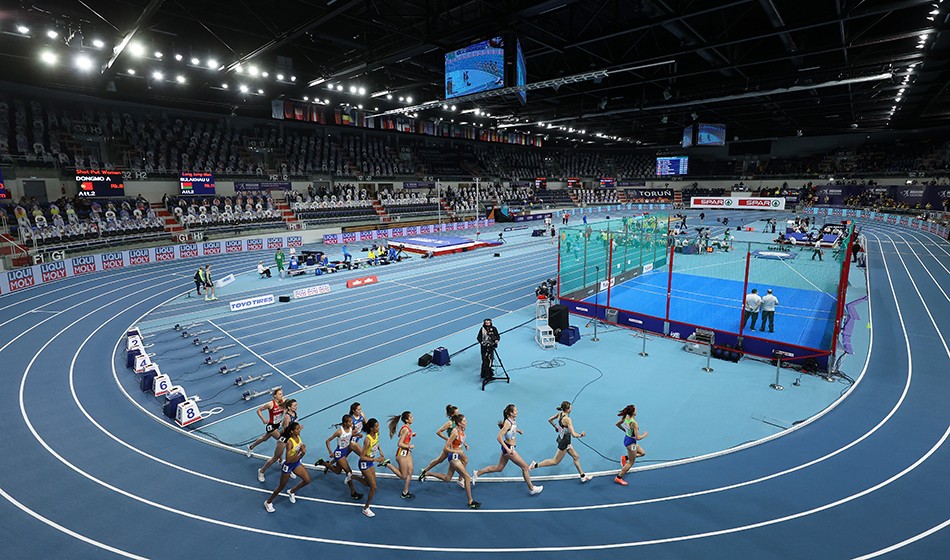
Global governing body plans to scrap traditional indoor track and field records in favour of a new short track format which will feature all year round
World Athletics is replacing indoor athletics with short track to describe events and performances that are set on a 200m track. The move has arisen partly due to the growing trend of city centre competitions and is set to be rubber-stamped at the global governing bodys council meeting in Budapest in August.
World Athletics says its council is supporting the concept of short track competition to allow more flexibility in the setting of 200m tracks, which may, in the future, be constructed outdoors or in temporary city locations, rather than in a traditional indoor arena. Performances set on outdoor or temporary 200m tracks could therefore be recognised as official results for the purpose of records and rankings.
WA president Seb Coe said: This change is designed to remove an unintentional barrier to competition innovation, by offering organisers the chance to explore solutions and opportunities which the current rules may discourage.
Under this new concept, the 200m short track will no longer be confined to the indoor environment, and a world of opportunities will open up for meeting organisers to stage official competition in whatever facilities they have available, either indoors or outdoors, using 200m or 400m tracks.
This change will allow and actively encourage the possibility for 200m tracks to move to an outdoor environment and will provide a more affordable option to cities, especially where space is in short supply, while stimulating the growth of the sport through investment in new infrastructure.
It is a bold move by World Athletics that will raise eyebrows in the sport. As the governing body says itself in a statement, the sport has been divided into outdoor and indoor competition for more than 150 years.
There is debate as to when indoor athletics actually began but one of the earliest contenders for the first-ever meeting took place in January 1859 at Londons Lambeth Baths when a former English swimming champion called William Beckwith won a 22 bet by jumping 500 hurdles, 10 yards apart, under 40 minutes an achievement that took him less than 30 minutes and was watched by around 400 spectators.
Whereas England might have been first when it came to staging formal indoor athletics competitions, much of the sports early growth subsequently took place in the United States. There is evidence that an indoor athletics event took place in Cincinnati as early as 1861 but the first properly documented event was in 1868 shortly after the New York Athletic Club (NYAC) was founded. Around 2000 spectators gathered in the gas-lit Empire Ice Skating Rink in the city, for example, to watch events such as a high jump, shot put and half-mile race amid a backdrop of musicians playing a Bellini overture.
Wembley indoor arena
The first official US indoor championships took place in 1906 with the Millrose Games starting in 1914. In Britain, the first AAA Indoor Championships was staged at the Empire Pool at Wembley in London in April 1935.
In the UK the Midlands venue of Cosford dominated as the premier indoor athletics venue from 1955 onwards and it went on to hold televised internationals from 1965 to 1991 with athletes like Seb Coe, Daley Thompson and Geoff Capes in action.
A one-day European Indoor Games was held in Dortmund in 1966 on a 160m track and it proved such a success that it evolved into the European Indoor Championships with the most recent edition being in Istanbul in March this year.
A global championship took a little longer to happen but in 1985 a World Indoor Games was piloted in Paris with winners including Sergey Bubka in the pole vault, Marita Koch in the 200m and Patrik Sjoberg in the high jump. The event quickly became established with the first official championships in Indianapolis in 1987 and has since been held in such varied locations as Toronto, Maebashi and Doha.
Seb Coe at Cosford (Mark Shearman)
Cosfords reign as the home of indoor athletics in the UK came to an end in the early 1990s when the NIA in Birmingham opened and the Kelvin Hall in Scotland began staging big meetings such as the 1990 European Indoors. This was followed by 200m indoor tracks being built in Sheffield, Cardiff, Lee Valley and Manchester, plus a number of indoor sprint straights and jumps and throws facilities in places like Loughborough, Bath, Gateshead and Alexander Stadium in Birmingham.
Recent years have also seen the growth of city centre competitions. Most notably the Great Run Company staged CityGames events in Manchester, Stockton and Newcastle-Gateshead which famously included Usain Bolt setting a world record over 150m, although the Jamaican star never raced indoors in the winter.
Usain Bolt (Peter Langdown)
Ironically these CityGames events in the UK are no longer running, but it is this trend that has partly inspired World Athletics new short track format idea.
World Athletics explain: The advent of modern athletics and the development of hybrid competition venues city squares, shopping malls, train stations it is becoming increasingly difficult to maintain the separation between outdoor and indoor athletics. In some field events, the separation has been eliminated altogether for world record purposes. This evolution has prompted World Athletics to redefine the boundaries of outdoor and indoor athletics, so they relate to the competition facility rather than to the environment.
World Athletics adds that indoor championships will continue to exist but in areas where there are few indoor facilities then short track championships can be used as qualifying competitions for major indoor championships.
